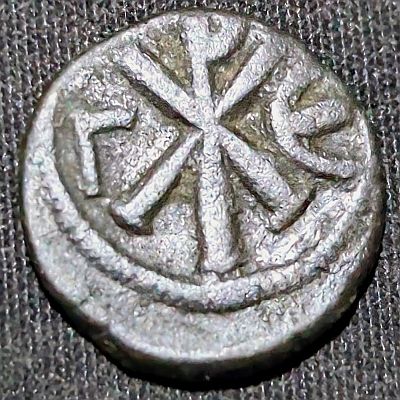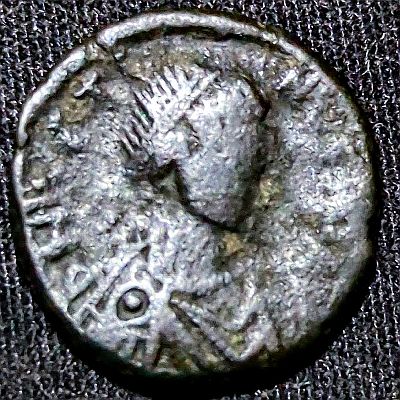Early Christian coins are fascinating for me as someone of faith, 1500 years later.
Reverse

The Chi-Rho ☧ is one of the earliest Christian symbols. Combining the Chi (X) and Rho (P), the first two letters of the Greek word ΧΡΙΣΤΟΣ or Christos. Chi-Rho is a Christogram, a monogram forming an abbreviation of the name of Jesus. IX (Basically a *, like the Chi-Rho but without the top of the P) is a similar form, using the initials of the name Ἰησοῦς (ὁ) Χριστός, ‘Jesus (the) Christ’, as is the ΙΗ monogram (), using the first two letters of the name ΙΗΣΟΥΣ, ‘JESUS’ in uppercase. The Chi-Rho was displayed on the labarum military standard used by Constantine I in 312 CE. Hubert Herald has many pictures of historical Christograms on coins and other artefacts.
Off-center
This coin is also interesting as being struck about 15% off-center, above the flan. On modern mint issued coins, an “error” of this type can command quite a premium. On older, hand struck coins, it can be more common. I still find it notable here.
Value
The rounded E (ϵ) on the right is the symbol for the value, 5 Nummi. The Γ left, denotes the 3rd Officina. I don’t have a handy reference of how much 5 Nummi was worth when this coin was issued, however Forum Ancient Coins has some details of value from several hundred years earlier.
Obverse

The coin was issued under Byzantine emperor Justin I. So taking a step back to just what the Byzantine empire was: By the third century, the Empire had become too large to be ruled by one person. In 285 AD, emperor Diocletian split the empire in East and West. In 330 AD, emperor Constantine moved the capital of the Roman Empire to Byzantium (Constantinople) in the Eastern Roman Empire.
This coin was issued sometime during Justin’s reign, between 518-527 AD. The orientation is interesting, at about 225° – Holding the coin with the portrait upright, the top of the Chi-Rho is at about 7pm. The text around the portrait seems to fit Justin I “D N IVSTINVS P P AVG”. There is a piece issued under Justinian I with a slightly longer inscription “D N IVSTINIANVS P P AVG”, which notes having this particular alignment. The Justinian I coin had the same reverse and was issued 527 – 535 AD. I can make out DNISTI on the left side, and NVS then maybe two or three more letters after that, so I am fairly confident this was issued under Justin I, although it demonstrates how tricky it can be to attribute coins sometimes.


Leave a Reply